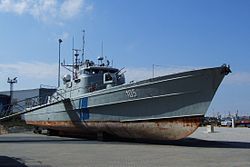 Lithuanian Navy Skalvis (ex-Norwegian Steil) | |
| Class overview | |
|---|---|
| Operators | |
| Built | 1965–1967 |
| Completed | 20 |
| General characteristics | |
| Type | Patrol boat |
| Displacement | 138 tons |
| Length | 36.5 m (119 ft 9 in) |
| Beam | 6.2 m (20 ft 4 in) |
| Draught | 1.8 m (5 ft 11 in) |
| Propulsion | 2 × Maybach diesel engines (7,200 hp (5,400 kW) total) |
| Speed | 30 knots (56 km/h; 35 mph) |
| Complement |
|
| Armament |
|
The Storm-class patrol boat was a series of fast patrol boats (FPB) consisting of 20 vessels built for the Royal Norwegian Navy.
Contents
- Design
- Operational history
- Vessels
- Gallery
- HNoMS Blink P961 - Outside
- HNoMS Blink P961 - Inside and under deck
- References
- Citations
- Sources
- External links
In Norwegian these boats were called missilkanonbåter (MKB) meaning boats with missiles and guns. They were operated by the Coastal Combat Flotilla together with the MTBs, or missile torpedo boats. None of the boats are currently in service with the Royal Norwegian Navy. The design was Norwegian and all of the boats were built by Norwegian ship yards from 1965 to 1967. In the 1990s, Norway donated vessels of the class to Estonia, Latvia and Lithuania.










